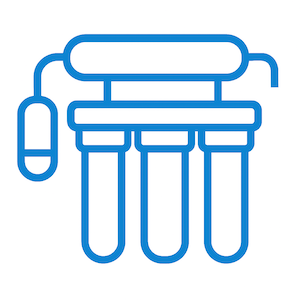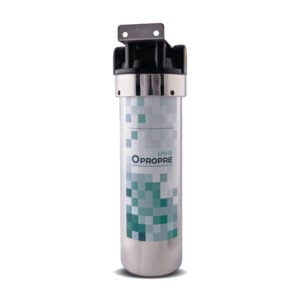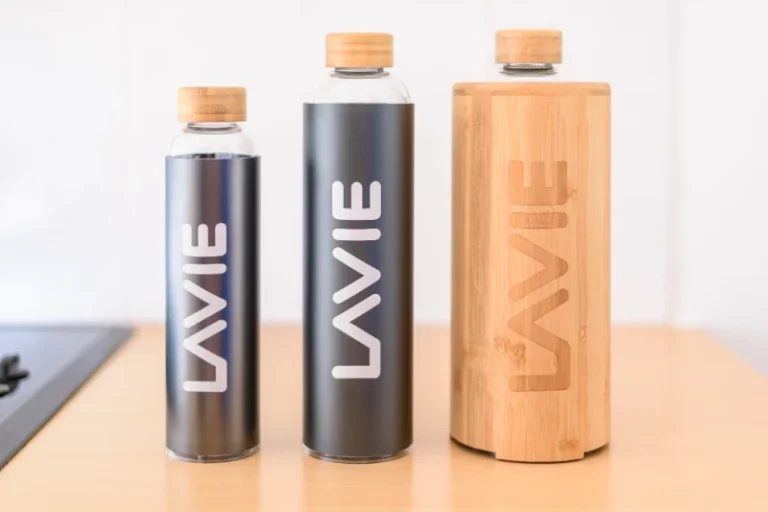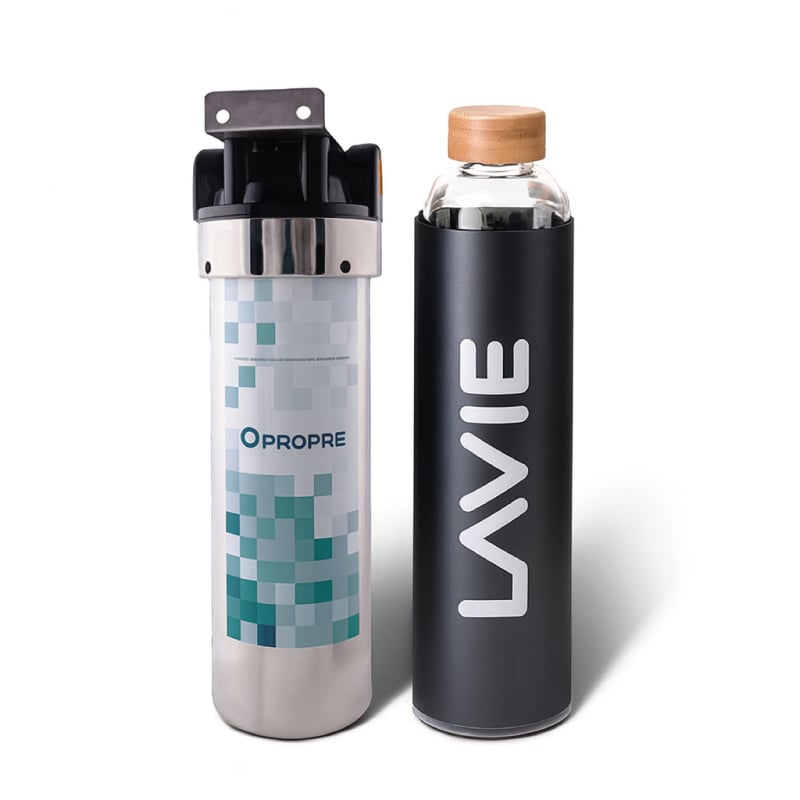
30-day money-back guarantee *
30-day money-back guarantee *

Le tap water purifier has become a very common product in French kitchens over the years.
Although the quality of tap water is closely monitored by the public authorities in France, and is subject to serious controls, there are still significant differences from region to region.
These differences relate to the presence of higher or lower levels of traces and residues of pesticides, bacteria, limescale and chlorine. All these elements have an impact on the taste and odour of tap water.
Despite this, not all tap water filtration solutions on the market are created equal.
To help you choose the right filter for your needs, this article compares 5 types of water purifier: the carafe filter, the under-sink filter, the on-tap filter, the osmosis unit and the UV-A purifier.
To get you started, here's a comparative table of different water filtration or purification systems, based on a number of criteria including water quality, price and the environmental impact of the solutions.
In this buying guide, we'll go into more detail about the features of the products to help you choose the option best suited to your needs.
Classic carafe filter |
Tap filter |

Osmosis unit |

Opropre under-sink filter |

UV-A carafe LAVIE |
|
| Purification method | Activated carbon filter | Activated carbon filter | Semi-permeable membrane | Activated carbon filter and targeted anti-PFAS resin | Ultraviolet rays (photolysis of chlorine) |
| Water quality | 💧 | 💧 | 💧 | 💧💧💧 | 💧💧💧 |
| Filtered / treated elements | Chlorine Sediment |
Chlorine Sediment |
Chlorine Sediment Bacteria and viruses Heavy metals Pesticides Trace elements |
Chlorine Sediment Heavy metals Pesticides PFAS |
Chlorine Bacteria Virus Traces of medicines Pesticides |
| Difficulty of installation | ✅ Easy |
✅ Easy |
❌ Complex (Professional recommended) |
🟠 Average (To be installed under the sink) |
✅ Easy to use (plugs into mains) |
| Environmental impact | ⚠️ High frequent waste (filters), non-recyclable |
⚠️ High frequent waste (filters), non-recyclable |
❌ Very high Discharge of polluted water (3-4 L per litre purified) + disposable filters + disposable membrane |
✅ Low LAVIE cartridges: returnable and refillable. Recycled activated carbon. |
✅ Low No filters, no consumables, low power consumption. |
| Initial cost | € | € | €€€ | €€ | €€ |
| Maintenance costs / consumables | €€ | €€ | €€ | € | No |
| Discover | Discover |
There are many different types of water filter. This proliferation of filtration and drinking water treatment systems on the market has sometimes led to a lack of choice. tend to question or even lose the consumer.
Let's take a look at the questions to ask yourself to guide you in your purchase.
Our first tip for choosing the right water purifier is to know the quality of your tap water.
You can check the quality of your local drinking water by visiting the Ministry of Health website. A water quality test can also help you determine the level of contamination in your water, the pollutants it contains, as well as its level of hardness and pH.
The different water filtration solutions vary considerably in price.
La carafe filter and tap filters are generally the cheapest options to buy, with models ranging from 20 to 120 euros. However, you will need to add to this the regular cost of changing water filter cartridges, which varies according to brand, manufacturer and model.
A system that, in the long run, is not necessarily the most economical, nor the most environmentally friendly !
Another disadvantage is the size of the carafe container, which can be too small if you have a large family, and the filling time, which can take up to 15 minutes! Plastic models quickly turn white because the filtered water is acidic, making them a real breeding ground for bacteria (Que choisir 2016 study).
The under-sink filters like those in our range Clean require a more complex installation and have a higher initial cost (between €100 and €300), but their method of filtration is more efficient.
Filters also last longer (change every 6 months, as opposed to every month for a carafe!).
To minimise the impact of our Opropre filters on the environment, we have chosen to consign filter cartridges to recharge them with activated carbon, while the used carbon is recycled in specialised industrial circuits. The PFAS resin in the Turquoise product follows the same circuit to eliminate concentrated pollutants.
You can't do it in your oven, because these materials have to reach 900 to 1200°C to destroy pollutants such as PFAS!

A water osmosis removes up to 99% of contaminants from water, but it's expensive to buy, install and maintain. You can expect to pay between a few hundred and a few thousand euros for these appliances, depending on the brand.
Osmosis units filter so well... that they retain 95% of mineral salts through their membrane. It is therefore essential to add more at the end of the process. But this function is only available on top-of-the-range machines, which use an additional consumable in the form of a mineral cartridge. Not to mention the fact that they generate 70% of water concentrated in pollutants during the filtration process...
You also need to watch out for bacteria nesting after the reverse osmosis membrane, for example in the remineralisation filter, the tank or the outlet pipes to the tap. More chlorine means zero bacterial protection - it's the same problem as with carafes, so to speak.
Yes, it does exist!
These innovative filterless water purifiers use UV-A to treat tap water and make it purer.
The purification system is based on the emission of ultraviolet light (UV-A) which neutralises contaminants in the waterIt's the perfect way to remove all kinds of harmful substances, such as chlorine, bacteria, viruses and pesticides, without the need for filters or consumables! Isn't LAVIE beautiful?
In just 15 minutes, the water purifier transforms tap water into water free of its chlorinated taste and impurities. In short, thanks to their innovative and practical design, you can use your LAVIE bottle like a filter jug... without needing a filter! What's more, the one-litre bottle fills up in 6 seconds, so there's no need to struggle to fill your jug several times...
Budget-wise, the price varies between 100 and 500 euros depending on the size of the tank.

A water softener is a separate system, designed to reduce water hardness by removing limescale and other minerals.
In other words, it is not capable of filtering chlorine, bacteria, heavy metals and other contaminants from tap water for consumption. You need to specialise it for hot water or risk completely destroying the quality of your tap water, or use our salt-free softener. Odouce salt-free softenerHot and cold water compatible.
This question goes back a little to the first, on the tap water quality in your local area.
For example, if chlorine are high (and therefore produce water with odours and a bad taste), a purification method that acts directly on the chlorine should be favoured!
There are several treatment methods for purifying tap water, including distillationfiltration, reverse osmosis or gravity filtration, the activated carbon filtration or the UV-A purification.
Tap purifiers, under-sink purifiers and filter carafes mainly use filters containing activated carbon. The osmosis unit uses a semi-permeable membrane to eliminate contaminants, while the UV-A purifier uses ultraviolet rays to convert chlorine into powerful oxidants.
Here is a summary table of the different elements filtered or eliminated according to the solutions:
|
Element filtered, reduced or eliminated |
Classic carafe filter |
Tap filter |

Osmosis unit |

Opropre under-sink filter |

LAVIE Purifier |

Peace of mind pack (Opropre + LAVIE PURE) |
| Chlorine | ✅ | ✅ | ✅ | ✅ | ✅ | ✅ |
| Sediment | ✅ | 🟠 | ✅ | ✅ | ❌ | ✅ |
| Bacteria | ❌ | ❌ | ❌ | ❌ | ✅ | ✅ |
| Virus | ❌ | ❌ | ❌ | ❌ | ✅ | ✅ |
| Medicines | ❌ | ❌ | ✅ | ✅ | ✅ | ✅ |
| Pesticides | ❌ | ❌ | ✅ | ✅ | ✅ | ✅ |
| Heavy metals | 🟠 | 🟠 | ✅ | ✅ | ❌ | ✅ |
| PFAS | ❌ | ❌ | ✅ | ✅ | ❌ | ✅ |
| Microplastics | ❌ | ❌ | ✅ | ✅ | ❌ | ✅ |
| Mineral conservation beneficial |
❌ | 🟠 | ❌ | ✅ | ✅ | ✅ |
| Discover | Discover | Discover |
Our recommendations for purer tap water every day?
Associate an Opropre under-sink filter to a LAVIE water purifier to take advantage of their respective benefits. In other words, water that is free of heavy metals, pesticides and microplastics, as well as bacteria, protozoa, viruses, traces of medication and other contaminants! All while preserving all the beneficial minerals naturally present in the water.

💧 Still not sure? Find out here about benefits of filtered water thanks to LAVIE products.
L'installing your water filter must be quick and easy to use, with no constraints.
By their very nature, carafe filters and tap purifiers are simple to install and use.
Similarly, the LAVIE water purifier You don't need any special skills to install it, as all you have to do is plug it into a mains socket!
Le Clean filter requires a specific under-sink installation, but this can easily be done without the help of a professional.
On the other hand, installing a reverse osmosis system requires the intervention of a professional and will require occasional maintenance.
Depending on their features, some water purifiers consume more energy than others. If you're concerned about our planet's environment and/or want to reduce your electricity bills, choose an energy-efficient model. The LAVIE purifier, for example, uses a low energy consumptionA water distiller consumes around 40 times as much.
Filter carafes and filters on taps and under kitchen sinks do not consume energy, but they do have the following advantages produce waste through filters.
But you should be aware that the energy costs of some purifiers are sometimes more than offset by the benefits they provide. the abandonment of plastic water bottles. The manufacture of these products is not only energy-intensive, it's also an environmental disaster. And let's not even mention the waste dumped into the ocean...

Not to mention the environmental impact of the plastic waste they generate, conventional tap water filters have other drawbacks that should not be overlooked.
In particular, ANCES has issued a mixed opinion on classic filter carafesIn a study of the filtration process, they found compounds at the filtration outlet (carbon, silver salts, bacteria in "non-drinking water" quantities, etc.) that were not present in the inlet water (more info here).
In other words, if the cartridge is not replaced regularly, and the carafe used under the right conditions, filters can become veritable "bacteria nests". which degrade rather than improve water quality and are likely to pose health risks.
What's more, all domestic drinking water filtration systems require regular maintenance.
Over time, particles and impurities clog the filters, reducing their efficiency and leading to poor water quality. The flow rate and pressure of your tap can also be affected.
Finally, some filter purifiers, such as osmosis units, can be bulky (and unattractive!) and require space to install. Prefer a compact design like our Opropre range.
It is therefore important to take all these disadvantages into account when choosing a water filter that suits your needs and lifestyle.
Plastic bottled water is an alarming cause of pollution and should be avoided.
Plastic water bottles are one of the most important categories of most polluting products. Their manufacture has a major impact on the environment, and their daily use contributes to the pollution of oceans and natural areas. As the Save4PlanetThe plastic waste polluting our oceans comes largely from plastic water bottles.
One of the other main disadvantages of plastic bottles is their high purchase price. Bottled water is, as we are reminded What to choose, 65 times more expensive on average than tap water! !
An article in Dauphiné also analyses that a French household can spend between 200 and 800 euros in bottled water purchases per year. Not to mention the unpleasant experience for your back and the inconvenience of having to carry around hundreds of litres of water and the space required to store them...
Not sorting bottles in the yellow bin is a luxury that you'll soon get used to!
Now you know the majority of the disadvantages of the domestic water filter or buying water in plastic bottles.
Does this mean you should give up on the idea of improving the quality of your domestic water?
Obviously not! There are alternative, innovative solutions that don't use water filtration systems and that deliver better results.
LAVIE water purifiers, which use a special purification system without water filterThese products meet these specifications. Instead of using filtration to purify tap water, they use UV-A radiation which destroy the chlorine present in tap water, creating a chain reaction that purifies the water of its other contaminants.
Within 15 minutes, your tap water is free of chlorine and the undesirable odours and flavours that accompany it. What's more, the chemical reaction that breaks down the chlorine is accompanied by the destruction of other impurities, such as pesticides and drug residues.
💧 To find out more, visit our shop at water purifiers or consult the reports of our scientific tests made in France.
The various filtration systems available on the market make it possible toimprove the taste and quality of tap water.
In terms of filtration finesse osmosis units are the best filters because they retain almost all the substances in the water (even the good ones!). However, this high efficiency comes with numerous constraints. They are more expensive than other filtration solutions, and more complex to install and maintain. Most importantly, the reverse osmosis process rejects 2 to 4 litres of contaminated water per litre of filtered water (yes, you read that right!), which makes its use neither sustainable nor environmentally friendly. The output water is acidic because it contains no minerals, and its calcium/magnesium content is below the minimum set by the WHO. In other words, the water is undrinkable, and more suitable for lead batteries than for human beings.
Among the most affordable options on the market, the carafe filter is a popular choice, but its reservoir capacity and filtration efficiency are limited. What's more, its positive effects on water quality can be 'cancelled out' or even 'reversed' if the filters are not changed regularly (every month) and if the carafe is not used under the recommended conditions.
A practical, economical and ecological solution, LAVIE water purifiers use a scientifically tested UV-A purification process. that makes tap water healthier and purer in just a few minutes (destruction of chlorine and bacteria, reduction in pesticide levels, drug residues, etc.), without the need for a filter!
Combined with our Opropre under-sink filterThe LAVIE system is ideal for regular consumption of quality water, without maintenance problems and with the greatest respect for the environment.
Important selection criteria include filtration efficiency, installation and maintenance costs, environmental impact and ease of use and maintenance.
The LAVIE water purifiers use the photolysis of chlorine by UV-A rays to inactivate micro-organisms present in the water, such as bacteria or viruses. This purification method is effective in eliminating pathogens without the use of chemicals, while preserving water quality.
If you're looking for very advanced filtration, a reverse osmosis system is a great choice... but also very restrictive It eliminates beneficial minerals from the water, wastes a lot of drinking water (2 to 4 litres of waste water for every 1 litre of filtered water) and requires regular maintenance.
The LAVIE water purifier offers a practical and innovative alternative, without filters or consumableswhich effectively neutralises contaminants while preserving water's essential minerals. The best choice for purer water on a daily basis, without any constraints!
Yes, filtering tap water is good for your health, because it removes chlorine, heavy metals, pesticide and drug residues, and certain bacteria and viruses that can cause illness.
However, make sure you choose a system that is suited to the quality of your water and that you use it in the right conditions! A poorly maintained filter, for example, can do more harm than good.
That's why solutions like LAVIE purifier are interesting: they improve the quality of tap water without the need to change filters, and without altering the quality of the water.
The capacity of the water purifier is another aspect to consider. If you have a large family, you'll need a water purifier with greater storage capacity.
Carafe filters have a limited capacity and need to be refilled regularly (which can take a long time). On-tap and under-sink purifiers have a higher capacity, while osmosis and UV-A purifiers can treat a large volume of water.
A suggestion : Consider glass fountains for the home. Equipped with different technologies, such as UV-A radiation, they can meet your needs at home!
Want to keep up to date with our water-related articles?
Subscribe to our Newsletter below
and get -5% on your first order!